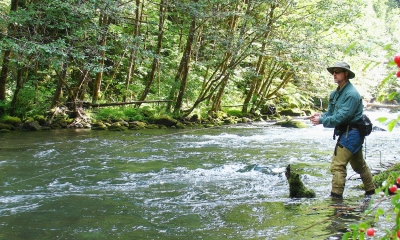
Warmwater fishing in Oregon: An introduction
Whether it's a 6-inch bluegill or a trophy-size bass, Oregon's warmwater fish offer anglers of all ages a variety of fishing opportunities. Check out some basic tips here, then head to the article that details places to go looking for warmwater fish species within the area of the state you're interested in.

Table of contents
Part 1: Warmwater Fishing in Oregon - An Introduction (you are here)
Part 2: Warmwater Fishing - North Coast
Part 3: Warmwater Fishing - South Coast
Part 4: Warmwater Fishing - North Willamette
Part 5: Warmwater Fishing - South Willamette
Part 6: Warmwater Fishing - Klamath-Lake Area
Part 7: Warmwater Fishing - Central Area
Part 8: Warmwater Fishing - John Day/Umatilla
Part 9: Warmwater Fishing - Northeast Area
Part 10: Warmwater Fishing - Southeast Area
Part 11: Warmwater Fishing - Southwest Area
What is a warmwater fish?
In Oregon, "warmwater fish" means largemouth and smallmouth bass, sunfish, crappie, channel catfish, bullheads, yellow perch, walleye and hybrid bass. None (except possibly the Sacramento perch) is native to Oregon, but most have been present since late in the 19th or early 20th century. They generally live in lower elevation ponds, lakes, reservoirs and streams where warm spring and summer water temperatures allow them to reproduce successfully.
Why fish for them?
Fishing for warmwater fish is a fun, low-cost, family-oriented outdoor activity. A minimal amount of simple equipment is needed, and you can usually find good fishing close to home. Warmwater fish can be easy to catch, making them ideal for kids and other beginning anglers. In addition, they are excellent table fare.
In this article series the state is broken out into 10 areas where warmwater fishing can be found. Each area page features information about the species of warmwater fish available there, how to fish for them, and where and when to go. The table lists at the bottom of each page indicate good places to fish, the fish species present, and information on boat and bank access and amenities, such as restrooms or nearby locations to buy fishing licenses and tackle. One waterbody in each area is highlighted because of the quality fishing it offers. Beginning anglers can be successful using basic fishing tackle and the set-ups shown below.
Basic fishing tackle
- A 5½ to 7 foot medium-action rod with spincast reel is easiest to operate for a beginner
- 4- to 8-pound test line
- Hooks – Variety pack of bait-holder style with sizes 10, 12 or 14 for sunfish, crappies and perch, and sizes 4, 6 or 8 for bass, walleyes and catfish
- Sinkers – Variety pack with several sizes of split shot, sliding, and dropper styles
- Bobbers – Small tapered ones have less resistance and are less easily detected by fish when they bite
- Small barrel swivels (for slip-sinker rig)
- Crappie jigs
Rigging up
Different rigs and baits may work better at particular places and times of year, so ask a local bait or tackle shop for up-to-date fishing information.
Header photo by Chance Arnold





